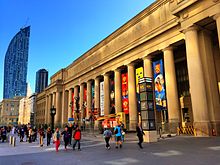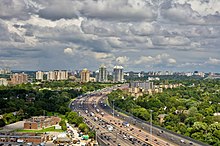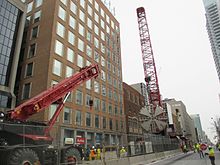Transportation in Toronto
Both companies operate major yards and intermodal facilities in various parts of Toronto to serve manufacturing and logistics customers.
Most waterfront trackage has been scaled back and abandoned in favour of real-estate development, with the remaining main lines in this area being almost the exclusive domain of passenger carriers.
Intercity coach companies operating services out of the Union Station Bus Terminal include Ontario Northland, Megabus, TOK Coachlines, Rider Express, Flixbus, and Greyhound Lines.
At the western edge of the city, the 401 meets Highway 427, an important north–south artery between Toronto Pearson International Airport and the Gardiner Expressway.
Moving east, the 401 then intersects Highway 400, which leads north to Barrie, the recreational areas of Ontario's "Cottage Country" and beyond, to the northern reaches of the province.
East of the 400, the 401 meets Allen Road, and then the Don Valley Parkway / Highway 404, before continuing eastwards out of Toronto into the suburbs of Pickering, Ajax, Whitby, and Oshawa.
Beyond the 401, this route is known as Highway 404, and connects the more distant outer suburbs of Markham, Richmond Hill, Aurora, and Newmarket to the 401.
Within the city, the Toronto Transit Commission (TTC) operates an extensive system of subways, buses, and streetcars, covering 1,200 km (750 mi) of routes.
The rest of the city is primarily served by a network of about 150 bus routes, many of them forming a grid along main streets.
A more distinctive feature of the TTC is the streetcar system, one of the few remaining in North America with a substantial amount of in-street operation.
Situated in Hamilton, 85 km (53 mi) southwest of Toronto, it is also a terminus for low-cost carrier, charter airline, and cargo traffic.
Cycling in Toronto has improved over the years as the residents and municipal government have become more interested in it as a form of transportation.
Two major off-road paved trails along the Don and Humber river valleys provide a backbone for transport on the east and west side of the downtown area.
[3] In addition to surface-level paths and sidewalks, a network of underground pedestrian tunnels are used to connect the various buildings in Downtown Toronto.
Underground pedestrian tunnels were used in Toronto since 1900, although the construction of the larger PATH network did not commence until the 1960s.
[4] The principal ferry service to the Toronto Islands is provided by the city's Parks, Forestry and Recreation division.
It was finally sold in April 2007 to the German company Förde Reederei Seetouristik (FRS) for a ferry service between Spain and Morocco across the Strait of Gibraltar, and the Spirit of Ontario I was renamed HSC Tanger Jet II and later as HSC Dolphin Jet, crossing the Kattegat between Aarhus and Kalundborg in Denmark.
[citation needed] The International Marine Passenger Terminal at 8 Unwin Avenue in the Port Lands, built to accommodate multiple visits per day by The Breeze, is currently[when?]
[9][10][11] The city also operates a ferry service to take passengers to and from the Billy Bishop Island Airport with its terminal at the foot of Bathurst Street.
Urban sprawl is a major factor: some commuters travel significant distances within the city and the surrounding GTA for employment.
Downtown-to-suburb and suburb-suburb commutes have been increasing as well, which existing public transit services are not organized to efficiently accommodate.
[13][14] One study found that the average commute time in GTA exceeds that of 19 larger or comparably sized cities.
[15][16] Other studies comparing international cities show that Toronto residents on average spend the most time commuting to work in North America and sixth-most overall in the world.
[17] In March 2004, the Ontario government announced the creation of the "Greater Toronto Transit Authority" (GTTA - not to be confused with GTAA, acronym for the Greater Toronto Airport Authority), renamed Metrolinx in December 2007, with the goal of facilitating improved integration between the city and suburban transport systems.
One key element to this integration would be a single fare system, called Presto, to improve the convenience of transfers between different transit agencies.








